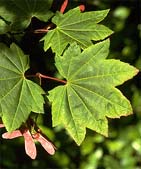
Plant Data
Sheet: Vine Maple (Acer circinatum)
Range
Vine
maple ranges from southwest
Climate,
elevation
Vine
maple is found from sea level to 1400 meters in elevation and prefers the
climate found west of the Cascades (4).
Local
occurrence
Vine
maple is a common plant in the
Habitat
preferences
Vine
maple prefers rich, moist, well-drained soils. It thrives in shade or in open areas
such as those listed above.
Plant
strategy type/successional stage
Vine
maple is found in the understory of both early and
late successional forests.
Associated
species
Companion species to vine
maple vary due to its wide variety of habitats. They may include: Douglas fir
(Pseudotsuga menziesii),
Western hemlock (Tsuga heterophylla), Western red cedar (Thuja plicata),
sitka spruce (Picea sitchensis),
Pacific silver fir (Abies amabilis),
red elderberry (Sambucus racemosa),
oceanspray (Holodiscus discolor), rhododendrons (Rhododendron spp.), huckleberry (Vaccinium spp.), sword
fern (Polystichum munitum),
Oregon grape (Mahonia nervosa), salal (Gautheria shalon),
foamflower (Tiarella trifoliata),
twinflower (Linnaea borealis), and bear-grass (Xerophyllum tenax)
(1).
May be
collected as: (seed, layered, divisions, etc.)
As a
poor seed producer, vine maple reproduces frequently through vegetative means in
the wild. It may be propagated
through seed, layering, or by collecting seedlings around parent shrubs
(4).
Collection
restrictions or guidelines
Generally, individuals over
the age of ten produce seed. The
seeds can be collected by hand or by shaking the tree. Collection should be done in September
or October as the samaras begin to dry (2,3,4).
Seed
germination
The
seeds require a warm, moist stratification at 20-30°C for 30-60 days, then a
cold stratification at 3°C for 90-180 days. For best results, the seed should then
be planted in trays and covered with leaf mulch. They can be stored indoors or outdoors
and will germinate in the spring.
The seedlings can be transplanted after one year (1,4).
Seed life
Information on seed life was
not available.
Recommended
seed storage conditions
Information on seed storage
was not available.
Propagation
recommendations
Seed
production in this species is not naturally high. In addition, seeds may be difficult to
germinate. However, the only other
propagation method available is branch layering of existing trees
(3). Thus, the
collection and propagation of seed may be the only practical method in some
situations.
Soil or
medium requirements
Unimproved garden soil is
sufficient for vine maple propagation.
A layer of leaf mulch is recommended (2).
Installation
form
Vine
maple can be transplanted after a year or two of growth. They can also be installed as bare root
material in the winter (1).
Recommended
planting density
Plants should be installed
with a spacing of 3-5 feet on center, depending on the desired final density and
estimated survival (5).
Care
requirements after installed
Seedlings should be watered
sparingly for the first summer after germination. After planting out, young seedlings
should be watered only when necessary (2).
Normal rate
of growth or spread; lifespan
Vine
maple is a long-lived deciduous shrub or small tree. It may reach heights of up to 15 meters
(4).
Sources
cited
(1) Hansen,
W. Native Plants of the Northwest. http://www.nwplants.com. Retrieved
(2)
King County Department of Public Works (1994). Northwest Native Plants: Identification
and Propagation for Revegetation and Restoration
Projects.
(3) Leigh, M.
(1999). Grow Your Own Native
Landscape: A guide to
identification, propagation, and landscaping with western
(4) Rose, R. et al (1998).
Propagation of
(5)
Sound Native Plants. http://www.soundnativeplants.com.
Retrieved
Data
compiled by (student name and date)
Sarah Baker